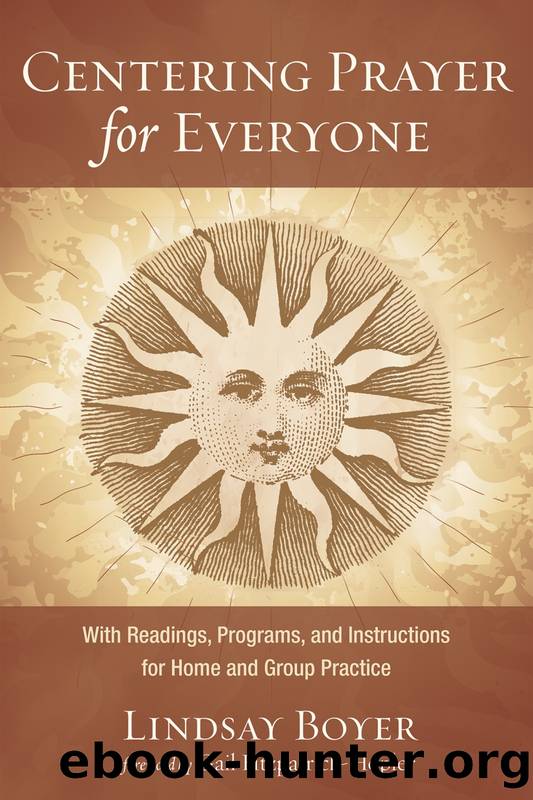Centering Prayer for Everyone by Lindsay Boyer

Author:Lindsay Boyer [Boyer, Lindsay]
Language: eng
Format: epub
ISBN: 9781532696824
Publisher: Wipf and Stock Publishers
Published: 2020-04-15T07:18:52+00:00
Planning and Leading a Contemplative Quiet Day
We can become deeply depleted and disconnected from the source of our being when we allow our culture and schedules to tempt us into ever greater levels of busyness. Many people long for greater periods of silence, reflection, and spiritual practice but have trouble making room in their packed schedules. A quiet day can be a refreshing time to step back and hear what our hearts have been trying to tell us through all the noise. What do we need? What do we want? We may have been rushing around so busily that we no longer know. Out of silence a still, small voice can arise and be heard.
There are many ways to offer a quiet day. I will use my own experience as an example, not because it is ideal, but in order to make this chapter as specific, practical, and vivid as possible. When I was learning from David Frenette how to lead a retreat, we would review in advance how each aspect of the retreat would unfold. No detail was too small for us to consider. This preparation enabled us to visualize and anticipate many eventualities so that we were ready to hold the space for the participants in a prayerful and hospitable way. I offer the details of this chapter in the same spirit. While you may end up making your quiet day quite different from what is described here, I hope these practical details will help you picture everything in advance.
Creating a Quiet Container
The most important part of the quiet day is the quiet. Resist the temptation to pack too many activities and talks into the schedule. Our culture bombards us with information and stimulation, and the quiet day is a time for a change of pace. Silence, spiritual practice and unstructured time can make up the core of the day. Leaving unstructured time for participants to do nothing creates a spacious feeling and allows for the possibility that participantsâ prayerfulness and playfulness will emerge in spontaneous and unexpected ways.
I usually allow at least an hour for a silent lunch during which people can eat, read, journal, nap, and reflect while enjoying the unusual experience of being with others without needing to talk to them. Often people tell me that this silent lunch is their favorite part of the day, reminding me that while the success of the quiet day can be enhanced by my careful planning, it is not dependent on my doing. Talks and activities can be kept short and simple.
Your role as facilitator is to hold the space for the participants by creating a welcoming environment in which they have permission to refresh themselves, turn off their cellphones, and listen within. The expression âholding the spaceâ might at first might seem like a figure of speech but describes a quality that participants can feel when they enter an environment that provides a hospitable container for whatever might be taking place within them. As a quiet day
Download
This site does not store any files on its server. We only index and link to content provided by other sites. Please contact the content providers to delete copyright contents if any and email us, we'll remove relevant links or contents immediately.
The 5 Love Languages: The Secret to Love That Lasts by Gary Chapman(9545)
The Space Between by Michelle L. Teichman(6829)
Assassin’s Fate by Robin Hobb(6084)
Wiseguy by Nicholas Pileggi(5628)
Everything Happens for a Reason by Kate Bowler(4640)
Gerald's Game by Stephen King(4540)
Pillow Thoughts by Courtney Peppernell(4185)
A Simplified Life by Emily Ley(4079)
The Power of Positive Thinking by Norman Vincent Peale(3973)
Resisting Happiness by Matthew Kelly(3281)
Harry Potter and the Prisoner of Azkaban (Book 3) by J. K. Rowling(3276)
Being Aware of Being Aware by Rupert Spira(3201)
Girl, Wash Your Face by Rachel Hollis(3191)
The Code Book by Simon Singh(3045)
More Language of Letting Go: 366 New Daily Meditations by Melody Beattie(2953)
Real Sex by Lauren F. Winner(2948)
Name Book, The: Over 10,000 Names--Their Meanings, Origins, and Spiritual Significance by Astoria Dorothy(2922)
The Secret Power of Speaking God's Word by Joyce Meyer(2898)
The Holy Spirit by Billy Graham(2862)
